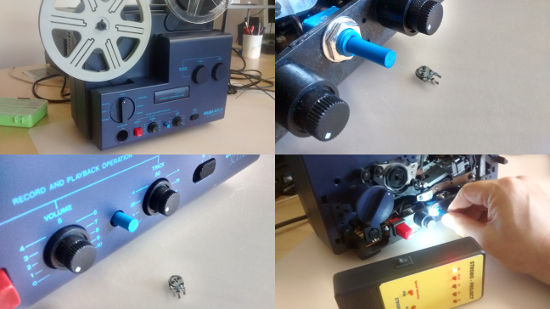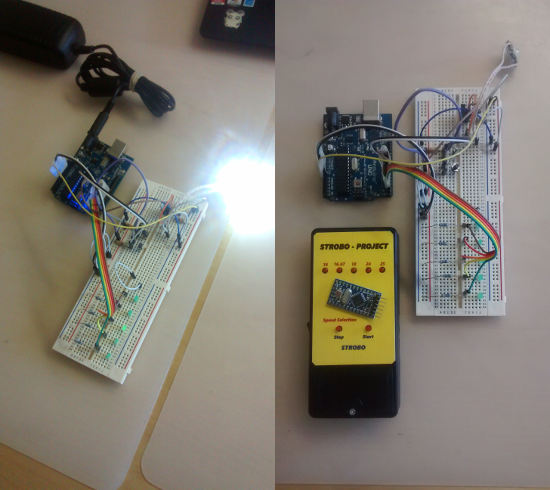|
Author
|
Topic: I need your suggestions and criticals about a speed test instrument
|
Renzo Dal Bo
Film Handler
Posts: 70
From: Mogliano Veneto, Italy
Registered: Dec 2016
|
 posted July 04, 2017 09:02 AM
posted July 04, 2017 09:02 AM




Hi everybody.
I need your expert help to improve my project. Any suggestions and criticals will be greatly appreciate.
For a long time, I have been searching a simple tool to quickly test the correct speed of a movie projector.
Unfortunately I did not find anything that met all my requests. In my mind it had to be simple to use, portable, battery supplied, without any projector disassembly and, above all, precise. So at the end I figured to build it myself taking advantage of the stroboscopic effect. First I realized a small working prototype, using an Arduino programmable board and a few other electronic components. The program I loaded on the board makes a power led flashing at specific frequencies, matching the common projector speeds. Due to the stroboscopic effect, when the projector runs at the exact speed, the main gear in the film path, illuminated by the intermittent light, appears to be motionless. In some projectors you can also act on the inside potentiometers to regulate the speed, if it was wrong, until the gear seems to stop itself. The tool I called "Strobo-Project" has only one main switch for power supply, ad two other push buttons. With the first push button you can select among five different speeds, showed by a corresponding turned on led, and in alternative stop the stroboscopic light. The second button turns on the stroboscopic light.
To test the accuracy of this instrument, I used two different projectors that can be synchronously controlled by a computer: an Elmo GS-1200 and a Braun Visacustic 2000. The final results were great and encouraging, despite the semplicity of the tool.
Now I am asking you about any improvement or changing you can suggest and think to be usefull.
Thank you all.
Renzo

[ October 06, 2017, 02:18 AM: Message edited by: Renzo Dal Bo ]
| IP: Logged
|
|
Phil Murat
Jedi Master Film Handler
Posts: 671
From: Villeneuve St Georges, France
Registered: Dec 2015
|
 posted July 06, 2017 01:18 AM
posted July 06, 2017 01:18 AM




Hi Renzo,
Very interesting and brillant device you introduced there, ,I love the idea , congratulation !!!
I suggest you also to put an enter in the French Forum from LE TRANSFERT .
You"ll find Electronic Fans who like designing projectors modifications for Super 8 digitalizing.
Working on an ARDUINO Card is a very good idea as these cards are powerfull and very popular now.
"Cherry at top of cake" ARDUINO's are cheap.......
Did you use the "ARDUINO UNO" Model ?
Just a question, do you mean "Main gear" as the lower or upper sprocket (there are different diameters/Tooth numbers depending on models, so I assume different speeds considering a same frame rate)?
If Yes, what do you think about adding a "Tooth number" Select P/B , 2 P/B for increase and derease,(as an exemple, allowing 10 to 40 tooth setting) and joined to a small LED display showing Tooth number selected ?
Phil
[ July 06, 2017, 03:26 AM: Message edited by: Phil Murat ]
| IP: Logged
|
|
|
|
Renzo Dal Bo
Film Handler
Posts: 70
From: Mogliano Veneto, Italy
Registered: Dec 2016
|
 posted July 07, 2017 08:07 AM
posted July 07, 2017 08:07 AM




Thank you Phil and Steve for your interest about my project.
@ Phil
I appreciate your offer to subscribe the french forum, unfortunately I don't speak french, but only a few english.
My instrument works for all the sprockets. It is not important which dimensions or teeth number they have. If the sprocket turns at the exact speed, every flash meets the next tooth in the same position than the previous one, so the sprocket appears to be stationary.
If the projector runs faster or slower you can regulate its electronic, if possible, until you see the sprocket apparently stops.
(When I was a child and was watching the Western Movies I didn't understand why the coach wheels turned in the opposite direction they should have had to go. Now I know it! It's the stroboscopic effect!)
Sometime ago a friend of mine asked me to modify his projector, that had only two fixed speeds (18/24 FPS). He wanted it worked to variable speed from 16 up to 25 FPS. I desoldered the internal 24 FPS pot and substituted it with an external potentiometer you can act on. To regulate the projector at the exact speed, I gave to my friend a Strobo-Project instrument.

I made the prototype of my project with an Arduino Uno board, but to realize the final instrument I used a smaller Arduino Mini Pro board. I agree with you these boards are very powerfull and cheap.

@ Steve
You are right Steve, to achieve something important it is necessary to dream it before. For sure my dreams are more down to earth and simpler than yours.
However to test my project I used a tool that makes your dream partially comes true. Look at the following photos.
For a few bucks, you can buy a tachometer for flying modellers .
They use it to test the propellers speed, so very similar to the shutters of our projectors. You have only to set the number of blades before (from 2 up to 9), and then you can read the propeller speed in RPM.
Just according to your requests it has "a phototransistor that detects the light pulses and inputs tachometer IC which puts out a voltage proportional to the frequency it measures" ... then displays on a digital LCD screen the speed, but unfortunately only in RPM.
I tested this tool also pointing it directly to the projector lens and it works very well but without the film in it. The shadows of the film frames make the misure less precise.
Reading what you wrote, I realized that I could input in my project the 20 FPS speed (expecially for US users with a 60Hz AC and 3 blades projectors).

Thank you so much again.
Renzo
[ July 07, 2017, 10:28 AM: Message edited by: Renzo Dal Bo ]
| IP: Logged
|
|
|
|
|



 UBBFriend: Email this page to someone!
UBBFriend: Email this page to someone!
 Printer-friendly view of this topic
Printer-friendly view of this topic



 UBBFriend: Email this page to someone!
UBBFriend: Email this page to someone!
 Printer-friendly view of this topic
Printer-friendly view of this topic